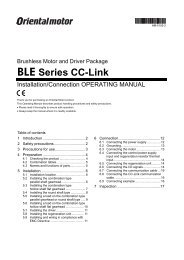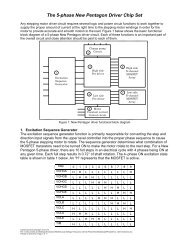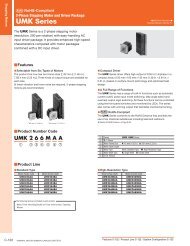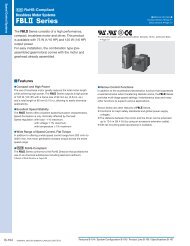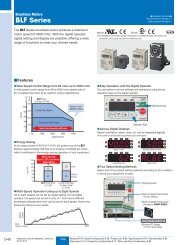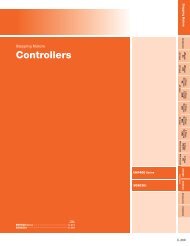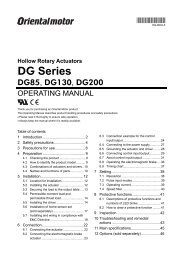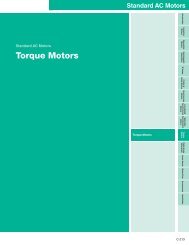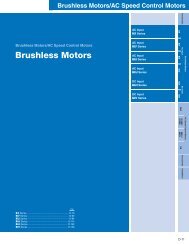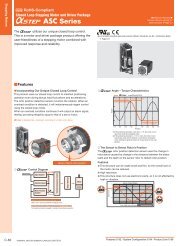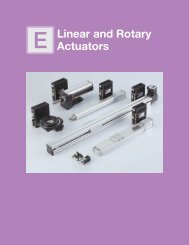Product Reference - Oriental Motor
Product Reference - Oriental Motor
Product Reference - Oriental Motor
Create successful ePaper yourself
Turn your PDF publications into a flip-book with our unique Google optimized e-Paper software.
Technical <strong>Reference</strong><br />
Changes in maximum starting frequency with the inertial load may<br />
be approximated via the following formula:<br />
fs<br />
f =<br />
[Hz]<br />
JL<br />
1 +<br />
J0<br />
fs : Maximum starting frequency of motor [Hz]<br />
f : Maximum starting frequency where inertial load is present [Hz]<br />
J0 : Moment of inertia of rotor [kg·m 2 (oz-in 2 )]<br />
JL : Moment of inertia of load [kg·m 2 (oz-in 2 )]<br />
●Static Characteristics<br />
◇Angle – Torque Characteristics<br />
The angle – torque characteristics show the relationship between the<br />
angular displacement of the rotor and the torque externally applied<br />
to the motor shaft while the motor is excited at the rated current. The<br />
curve for these characteristics is shown below:<br />
Torque T<br />
TH<br />
2<br />
3<br />
4<br />
TH: Maximum Holding Torque<br />
τR: Rotor Tooth Pitch<br />
Unstable Point<br />
Stable Point<br />
◇Vibration Characteristics<br />
The stepping motor rotates through a series of stepping movements.<br />
A stepping movement may be described as a 1-step response, as<br />
shown below:<br />
1 A single pulse input to a stepping motor at a standstill accelerates<br />
the motor toward the next stop position.<br />
2 The accelerated motor rotates through the stop position,<br />
overshoots a certain angle, and is pulled back in reverse.<br />
3 The motor settles to a stop at the set stop position following a<br />
damping oscillation.<br />
Settling Time<br />
Angle<br />
Forward Direction<br />
θs<br />
1<br />
t<br />
2<br />
Reverse Direction<br />
1-Step Response<br />
θs : Step Angle<br />
t : Rise Time<br />
3<br />
Time<br />
Vibration at low speeds is caused by a step-like movement that<br />
produces this type of damping oscillation.<br />
The vibration characteristics graph below represents the magnitude<br />
of vibration of a motor in rotation.<br />
The lower the vibration level, the smoother the motor rotation will be.<br />
−TH<br />
1<br />
θ<br />
τ<br />
5<br />
τ<br />
6<br />
7<br />
3<br />
R<br />
R<br />
4 2<br />
4<br />
Displacement Angle<br />
Angle - Torque Characteristics<br />
τR<br />
8<br />
1<br />
τR<br />
The following illustrations show the positional relationship between<br />
the rotor teeth and stator teeth at the numbered points in the<br />
diagram above.<br />
When held stable at point 1 the external application of a force to<br />
the motor shaft will produce torque T (+) in the left direction, trying<br />
to return the shaft to stable point 1. The shaft will stop when the<br />
external force equals this torque at point 2.<br />
If additional external force is applied, there is an angle at which the<br />
torque produced will reach its maximum at point 3. This torque is<br />
called the maximum holding torque TH.<br />
Application of external force in excess of this value will drive the<br />
rotor to an unstable point 5 and beyond, producing torque T (−) in<br />
the same direction as the external force, so that it moves to the next<br />
stable point 1 and stops.<br />
Stator<br />
Rotor<br />
Stator<br />
1 2 3 4<br />
5 6 7 8<br />
4<br />
4<br />
τR<br />
Vibration Component Voltage Vp-p [V]<br />
0.75<br />
0.50<br />
0.25<br />
0<br />
0 100 200 300 400<br />
Speed [r/min]<br />
Vibration Characteristics<br />
Rotor<br />
: Attraction between Stator and Rotor<br />
: Rotor Movement<br />
Stable Points:<br />
Points where the rotor stops, with the stator teeth and rotor teeth<br />
are exactly aligned. These points are extremely stable, and the<br />
rotor will always stop there if no external force is applied.<br />
Unstable Points:<br />
Points where the stator teeth and rotor teeth are half a pitch out<br />
of alignment. A rotor at these points will move to the next stable<br />
point to the left or right, even under the slightest external force.<br />
◇Angle Accuracy<br />
Under no load conditions, a stepping motor has an angle accuracy<br />
within ±3 arc minutes (±0.05˚). The small error arises from the<br />
difference in mechanical precision of the stator and rotor and a small<br />
variance in the DC resistance of the stator winding.<br />
Generally, the angle accuracy of the stepping motor is expressed in<br />
terms of the stop position accuracy, as described on the right.<br />
F-48 ORIENTAL MOTOR GENERAL CATALOG 2009/2010



